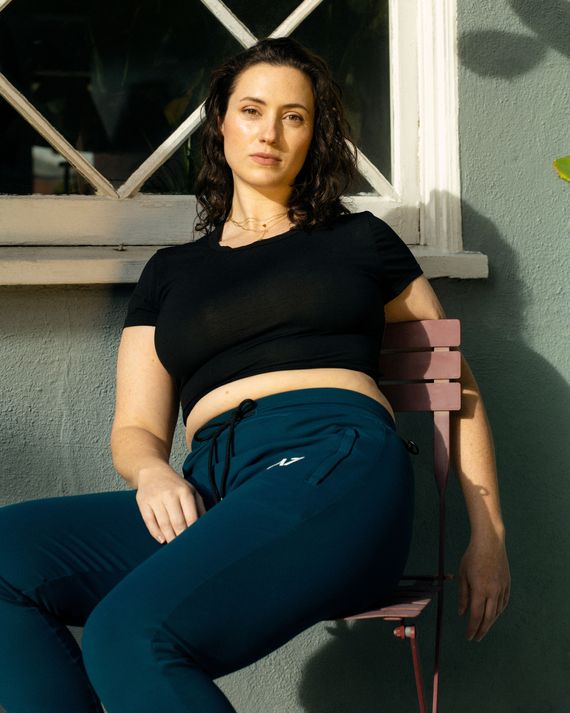
In a TikTok video she made to promote Liftoff, her beginners’ step-by-step weight-lifting manual, fitness writer Casey Johnston demonstrates the way she used to pick up a 40-pound box of kitty litter and carry it into her apartment. In this “before” scene, she goes through a series of painfully familiar contortions, scuttling, scrambling, and finally pushing the box through the door wheelbarrow style, butt in the air. The “after” video is about two seconds long; Johnston simply reaches down, picks up the box, and carries it inside.
The clip is simple but encapsulates what makes Johnston such an effective teacher, one who has convinced her readers that bulking up, not slimming down, is a worthy fitness goal: her willingness to put her imperfections on display to get her message across, her commitment to the quotidian benefits of lifting, and her body, which is, as you would expect from the author of an advice column called Ask a Swole Woman, commendably swole.
Since 2016, when she started writing the column, Johnston has been amassing an army of (presumably somewhat swole) followers. Readers migrated with her from the Hairpin to Self magazine, then to Vice, then to Johnston’s independent newsletter, She’s a Beast. Navigating the world of journalism hasn’t always been easy for Johnston, as you might guess from her column’s four-homes-in-six-years trajectory. In a previous media era, a voice-y expert with an established following might have spent 20 years writing for the same magazine; Johnston has had to be nomadic, then entrepreneurial. In the process, she became a self-publishing success story: Her newsletter has 21,000 subscribers, and Liftoff has sold 11,000 copies at $20 a pop.
No one whom Johnston spoke to in traditional publishing thought the book would sell. Agents and editors couldn’t wrap their heads around how to present the material. “‘Have you thought about making an app?’” Johnston says one of them asked her. “I was like, Good Lord.”
What makes Liftoff different from other books of its genre, besides Johnston’s charming voice and lightly worn expertise, is how she breaks down moves as plainly as possible. “I’ve read textbooks explaining how to lift weights, and it’s brain melting,” she says. So in her book, there’s no exercise physiology, no anatomical diagrams. Instead, there are straightforward descriptions of how to safely move weights from one relationship with gravity to another, plus links to YouTube videos of herself doing the moves.
It has been a particularly confusing January for those of us who live in bodies and consume culture. Whiplash abounds as we careen between newsletters and podcasts (Burnt Toast, Maintenance Phase) that remind readers of the diet industry’s insidiousness, then fly back to social-media feeds dominated by “before and after” weight-loss photos and “New Year, new you” ad campaigns. Even the most enlightened among us can’t help but notice that celebrities are currently thinner, the rise of their jeans lower; when we notice this, it has an effect on us. I asked a trainer at my gym whether she has witnessed a shift in how her clients talk about their goals, and she told me that while they had once wanted a big juicy ass, they’re back to using euphemisms for skinny like toned and lean.
“Doctors say, ‘Just work out.’ And the people on Reddit say, ‘Just eat less,’ ” Johnston says. “And if it were that simple, we’d all be doing it.” She is only too happy to talk me through this mess, though she warns me that she’s exhausted. She and her boyfriend celebrated a recent move to L.A. by getting a new puppy that’s still not sleeping through the night. She hasn’t been to the gym much herself lately, but as her readers might expect, she’s perfectly okay with that. The importance of rest, doing the fewest reps possible, is a leitmotif of her work.
It hasn’t always been this way for Johnston. She once starved and over-cardioed herself to the point that her feet and hands were always cold. Her eureka moment, and many of her readers’, hinges on a drawing of four avocados. The pit represents muscle, and the green flesh represents fat. When you restrict calories to lose weight, both pit and flesh get smaller. When you gain the weight back — inevitably — the pit stays smaller, a process that recurs every time you put yourself through this cycle. Lifting weights makes the pit bigger. A bigger pit, not less green stuff, should be the point of exercise, but we’ve been getting it twisted for years.
Johnston, who started lifting in 2014, is an ideal guide for strength-training novices because she remembers vividly what it was like to be one herself. “Eating like a big beautiful horse,” as one must do to build muscle, didn’t come easily to her. “I was afraid to gain weight in order to get stronger,” she says. She admits that one reason she started lifting was to look as good as a female lifter she had found on Reddit: “I was like, Oh, her body is looking conventionally hotter than it did before. And she’s doing it by working out way less than I am and eating way more than I am. That was compelling.” It’s refreshing to hear someone admit that their fitness goal was, at least at one point, skin deep.
And it’s unusual to read anything by a smart writer who’s so emphatically not neurotic. In part, she attributes her radiant sanity to — you will be stunned — lifting weights. The practice taught Johnston that consistent effort, rather than peak-intensity effort, is how change happens. As is true of a lot of her work, you don’t need to care about lifting weights to appreciate the insight.
Many of Johnston’s successes began as failures. About a year before Vice laid her off, she approached the newsletter platform Substack about a publishing deal. “I’ve never heard of an offer lower than this,” she says. “It was like, ‘We’ll pay you $75,000 for a year on a contract basis. For that year, you’ll get 15 percent of your subscription revenue, and we’ll keep 85 percent.’ But they did stipulate that you write at least twice a week, and that was a deal-breaker for me.” (A spokesperson said the company doesn’t comment on numbers but added, “We’d love for her to be on Substack again one day.”)
It turned out to be a great deal not to take. She instead runs She’s a Beast on the newsletter platform Ghost, where she “easily” earns enough income to pursue the project full time. She notes that, while there are bigger newsletters out there, her readers are loyal. “Not to throw shade at my cohort, but a lot of newsletters are just marketing. They engage in really pushy tactics to get people subscribed.” Then their open rates are low. “My engagement rate for paid subscribers” — who pay either $100 or $250 per year — “is 90 percent over the last 30 days. For free subscribers, it’s 80 percent. I’d rather have that than have a big list.”
A collection of essays that touches on the newsletter’s themes recently sold to the Simon & Schuster imprint One Signal in a “significant deal.” (As all readers of Publishers Lunch know, “significance” runs companies between $250,000 and $499,000.) Johnston hopes it’s a book readers return to whenever they need a reminder that being strong is better than being thin. “When I think about the media I really like, I think of Nancy Meyers movies. And that’s my vision for this book, that it be enduring in that way.”





